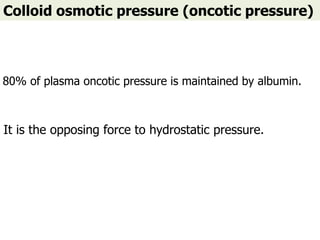lec 2_hematology_plasma_proteins.pptx
- 2. ▪Types of plasma proteins ▪ Characteristics of plasma proteins ▪ Functions of plasma proteins ▪ Hypoproteinemia and oedema Learning Objectives:
- 3. Plasma proteins Plasma contains ~ 7% protein, Normal total plasma protein is about 6.3- 8.4 g/dl
- 4. Classes of Plasma Proteins Albumins - 60% Globulins (α, β, γ) - 35% Fibrinogen - 4% Other proteins - 1%
- 5. Site of synthesis of Plasma Proteins ▪ Liver - 90% plasma proteins ▪ Plasma cell (B lymphocytes) - γ globulin ▪ Peptide hormones – Endocrine glands Liver dysfunction - plasma proteins A:G ratio (normal): 0.8-2.0., Decreased in liver dysfunction and chronic inflammatory conditions.
- 6. • Forms - 55%-60% of total plasma proteins Plasma protein - Albumin • Normal value - 3.5-5.0 g/dl • Molecular Weight (MW)- 66,500 D (lightest) ▪ Structure - a single peptide chain of 585 amino acids
- 7. Plasma protein - Albumin • Major function: Plasma Colloid Osmotic Pressure • Carrier Hypo-albuminemia ▪Liver disease, ▪Malnutrition ▪Chronic infection .
- 8. • Forms – 35% of total plasma proteins • Normal value - 2-3 g/dl; • Molecular Weight (MW)-90,000-150000 D • Type - Three types of globulin have been identified — alpha, beta, & gamma. Plasma protein - Globulin
- 9. Fibrinogen • Forms – 4%-6% of total plasma proteins • Normal value - 0.3-0.4 g/dl; .• Molecular Weight (MW)-4,00,000-500000 D • It is a plasma clotting factor, important for blood coagulation as can be converted into insoluble fibrin Molecules form clots, Produce long, insoluble strands of fibrin • It also contributes to the viscosity of blood.
- 10. Other Plasma Proteins 1% of plasma proteins: Regulatory proteins (cellular products) (1%): Hormones, Enzymes, and Prohormones
- 11. Methods of plasma protein separation Common methods of protein separation into: albumin, globulins (alpha, beta & gamma) and fibrinogen by – ▪ Electrophoresis ▪ Salting out ▪ Ultracentrifugation ▪ Affinity chromatography ▪ Fractional precipitation method ▪ Immune electrophoresis
- 12. Hypo-proteinemia • Liver failure • Nephrotic syndrome • Malnutrition • Malabsorption • Severe burns • Infection (↑catabolism) • Genetic
- 13. Functions of plasma proteins 1. Colloid osmotic pressure in blood 2. Viscosity of blood 3. Buffer action 4. Clotting and fibrinolysis 5. Defense function body 6. Transport function 7. Plasma proteolytic enzyme system 8. Plasma protease inhibitor system 9. Nutritional reserve
- 14. Colloid osmotic pressure (oncotic pressure) 80% of plasma oncotic pressure is maintained by albumin. It is the opposing force to hydrostatic pressure.
- 15. Colloid osmotic pressure (oncotic pressure) and filtration of fluid
- 16. Edema Due to disturbance in hydrostatic and/or oncotic pressure between intra-capillary and interstitial component.
- 17. • Brain: Cerebral edema • Lung: Intra-alveolar=pulmonary edema, intra-pleural=pleural effusion • Peritoneum=ascites • Severe generalized edema=anasarca • Leg edema- deep venous thrombosis Organ specific Facial oedema
- 18. Thank you

















